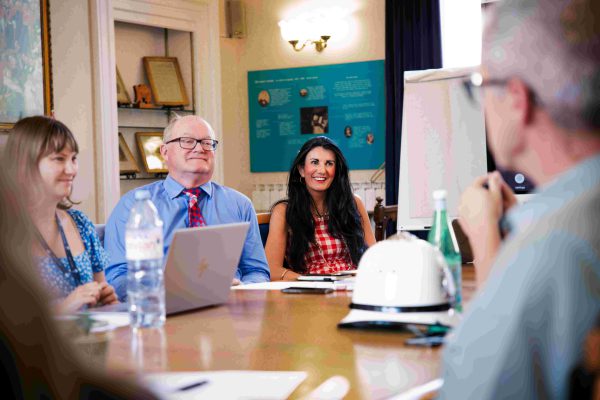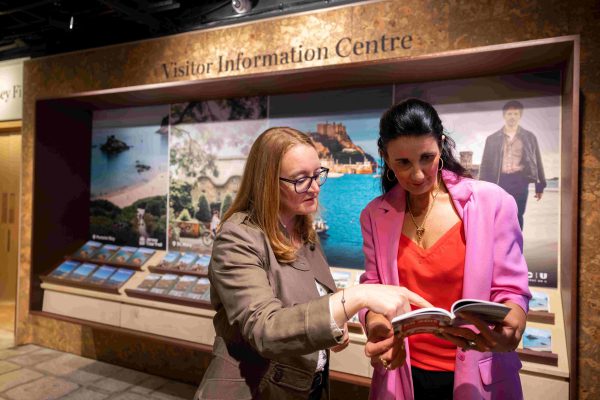
Jersey’s Government has recognised the importance of revitalising the town centre and supporting the visitor economy as part of its strategic priorities. But what steps are being taken to turn those policy decisions into action? Olivia Chaplin, Head of Visitor Economy, and Charlotte Howe, Head of Retail Economy, explain the work that is in progress
Before joining the civil service, Olivia worked for 15 years in hotel real estate, development, and investment across Europe on behalf of investors, banks and hotel chains. Charlotte spent 20 years in retail, starting in luxury goods with Louis Vuitton Moët Hennessy in France, then moving into health and beauty, holding roles from shop floor management to directing and leading various markets.
Physical and experiential changes to town
Revitalising St Helier is not just about new buildings or infrastructure; it’s about creating an environment that invites people in and encourages them to stay. Olivia explains: “It’s a combination of physical changes and less tangible things like animation, the sense of place, and the mix of businesses we have.”
Significant investment has gone into the public realm, managed by the Infrastructure Department but coordinated with the Department for the Economy. For example, there has been focused work on the Central Markets to bring them back to life as a key town asset. “We’ve had artists in residence, more events, and initiatives to make it a place people want to go to and spend time in,” Olivia says.

“Cornerstone events like Pride, and the Battle of Flowers being held in the town centre for the first time this summer, are really exciting” Charlotte Howe
Events are a major part of this animation strategy. The upcoming Battle of Flowers is moving into the town centre this year, alongside other festivals like the Delicious Food Festival and Genuine Jersey markets that draw locals and tourists alike. Charlotte adds: “Cornerstone events like Pride, and the Battle of Flowers being held in the town centre for the first time this summer, are really exciting. They’re bringing vibrancy, and that energy helps drive footfall into St Helier.”
This holistic approach – joining physical improvements, a thriving calendar of events, and coordinated support for local shops – aims to make St Helier not only more attractive but memorable. “It’s about focusing investment in the things that generate the best value for the Island,” Charlotte explains.
The evolution of iconic events: The Battle of Flowers
The Battle of Flowers parade has long been a cherished tradition in Jersey, but like many legacy events, it is evolving. Charlotte reflects on its future: “It’s good that things change and respond to what Islanders and visitors want. This year will be a test for the new Association running the event, to see if people like it being in St Helier and if it brings the vibrancy we’re aiming for.”
By relocating the event into the town centre, organisers hope to amplify its impact, create new opportunities for local businesses, and build a stronger connection between the event and everyday life in St Helier. The government is supportive but leaves the creative direction to the organisers, recognising the importance of flexibility in evolving traditions.
Supporting tourism and hospitality: Business support and connectivity
Beyond events and town improvements, the government is actively supporting the visitor economy businesses that form the backbone of tourism and hospitality.
Olivia highlights the Better Business Support Package – which includes a £1 million fund dedicated to the Visitor Economy for this year, with the same sum earmarked for next year – dedicated to helping businesses within the visitor economy transition into the living wage and invest in productivity and product development. “We’ve already seen strong take-up,” she says.

“Tourism is recovering well, spend is strong, and we’ve got new hotel applications and restaurants opening. There’s momentum building, and that gives us confidence we’re on the right track.” Olivia Chaplin
Marketing Jersey as a destination is also a key pillar. The government manages Visit Jersey, which has launched campaigns like “Where Sea Meets Soul” in London and elsewhere, driving international awareness. New flight routes have opened to key markets like Paris, improving accessibility.
The reimagined Bergerac television series also had a big impact on visibility of the Island, giving a gateway into what is known as the ‘set-jetting’ trend, which is people going to places they’ve seen on TV.
Connectivity remains a priority, as Olivia explains: “The key is to have those routes so people can get here. We’re focused especially on Europe.”
On the legislative side, updates to licensing and tourism laws aim to cut red tape and simplify event organisation and business operations, stimulating demand and making Jersey more attractive for both visitors and residents.
The living wage and business transition support
A significant challenge for the retail and hospitality sectors has been adjusting to the introduction of the living wage, combined with rising costs and housing pressures.
Olivia acknowledges these difficulties: “The living wage is part of a government commitment to fairness and reducing inequality. It helps ensure people in retail and hospitality can afford to live here. But businesses are balancing cost rises across the board, plus challenges in housing their staff.”
Upskilling staff through apprenticeships and career development is another focus, aiming to shift perceptions of retail and hospitality from transient jobs to viable long-term career paths.
Using data and research to guide strategy
Data and research are essential to understanding where Jersey’s economy currently stands and where it should go.
Olivia describes the government’s approach: “Everything we do is based on facts and evidence—whether that’s surveying retailers, looking at visitor data from Visit Jersey, or studying global trends. For example, the exit surveys show that shopping for non-essential goods is the top activity for visitors, which shaped our retail roadmap.”
Replacing the paper-based tourist GST refund scheme with the Global Blue digital version, and reducing the minimum value for eligible purchases, should also help the visitor economy. The ongoing analysis of hotel market openings and closures also helps anticipate future accommodation supply and demand, enabling better planning and support.
Signs of progress and reasons for optimism
After years of effort, both Olivia and Charlotte see encouraging signs that the town centre and visitor economy are on an upward trajectory.
Charlotte notes: “When you walk down the High Street and see vacancy rates dropping or empty shops under offer, that’s real change people notice. That growing vibrancy makes a difference to residents’ daily lives.”
Public investment in major assets within the visitor economy, such as the Opera House and the Elizabeth Castle renovations, sends a strong signal to the private investment market that the Government wants to see this growth happening – and is prepared to back that by stimulating or by investing itself.
Olivia shares her pride in the industry’s resilience and growing investment. “Tourism is recovering well, spend is strong, and we’ve got new hotel applications and restaurants opening. There’s momentum building, and that gives us confidence we’re on the right track.”
The key is adaptability, collaboration, and focusing on long-term quality experiences. For the people of Jersey and the many who come to enjoy its unique charm, the revitalisation of St Helier offers a hopeful, dynamic future.
Olivia Chaplin (Head of Visitor Economy) and Charlotte Howe (Head of Retail Economy) are the subjects of a Bailiwick Podcast. Click here to listen: How is the Government aiming to revitalise Jersey’s retail and tourism sectors?
 blog.gov.je
blog.gov.je